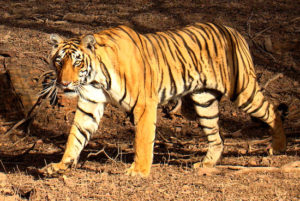By Aniket Patel and Anthony Cruz; Farnsley Middle School (Louisville, KY)
“Without Bengal tigers the Indian culture wouldn’t be the same anymore,” state Peter and Mina Patel.
Bengal Tigers are sacred animals that are protected in India and they are also endangered. According to Wikipedia, there are more than 50 reserves that protect tigers in India.

According to www.worldwildlife.org, Bengal Tigers are mostly found in India but there are a few in Bangladesh, Nepal, Bhutan, China and Myanmar. They live in grasslands, subtropical and tropical rainforests, scrub forests, wet and dry deciduous forests, and mangroves. They use their unique strips to camouflage in the wild. They live together during spring to have more cubs and then separate at the end of summer. They don’t live in packs and they live and hunt all alone.
“Between 1900 and1972, the Bengal tiger population dropped from 40,000-50,000 to under 2,000. This alarming decline has now slowed, thanks to a conservation program that enabled the creation of protected habitats” as stated by www.humanima.com (a website that informs about animals). With a current population of 4,000 individuals in southeast Asia, the Bengal tiger is the most numerous of the subspecies of tigers. Since they were announced the national animal of India, their population has gone up from 1100 to 2500 in India, but they are still considered endangered.
According to www.worldwildlife.org, bengal tiger have lost parts of their habitat due deforestation and rising sea levels. They have been hunted and poached for their fur. Also, they lost many of their prey due to habitat loss, which puts their population in even more danger.
Another danger to the Bengal tiger is poaching. In an email to Scijourner, Anant Pande a research student at the Wildlife institute of India, stated, ” Tiger poaching is largely driven due to a demand for its skin, bones, claws and other body parts in China and south east Asia. Tiger body parts are supposedly used in Traditional Chinese Medicine, which fuels its demand across the northern border of India.”
In April 1973, the project Save the Tigers was created by Indira Gandhi, then Prime Minster of India, and changed the National animal of India from the Asiatic Lion to the Bengal Tiger. According to www.Indif.com, (a website that is an unlimited source of Indian resources), “The Bengal Tiger symbolizes the power, strength, elegance, alertness, intelligence and endurance of the nation.” According to Wikipedia, in 2010 the Bengal Tiger was declared endangered by National Tiger Conservation Authority.
According to National Geographic, Bengal Tigers are carnivores and like to eat any mammal they can hunt down. They could attack humans for food but they prefer to eat other mammals and attack animal five times their size like elephants and rhinos. They could eat up to 65 pounds in one sitting.
“Male Bengal tigers measure 8 to 10 ft. (2 to 3m) in length, and can weigh from 440-650 lb. (200-300kg). Female Bengal tigers measure from around 8 to almost 9 ft. (2.5 to 2.6 m) and weigh in around 220 to 400 lb. (100 to 181 kg),” stated by tigersincrisis.com.
According to www.worldlife.org/India, solar lightning along the edges of the forests can stop Bengal Tigers from entering villages in suburban areas. It would also help to refuse to use products that have body parts of an Bengal Tiger and reduce the use of products from forests, such as timber and paper.
Peter Patel states, “Even though my family no longer lives in India, we care about India and the Bengal tiger because it is India’s national animal.”

This work is licensed under a Creative Commons Attribution-NonCommercial-NoDerivs 3.0 Unported License













